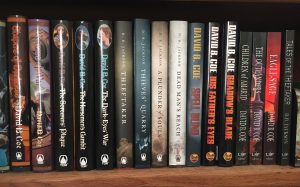They don’t care that the twelfth king of Hamsterdom was Belchamiethius IV, known to his subjects as “Conquerer of the Exercise Wheel.” They don’t need to know the names of each mountain peak in the Twelve Dunce Cap Range.
 This past weekend I gave a talk on world building for the Futurescapes Writers’ Workshop. It was a lengthy talk, and I’m not going to repeat all of it here. But I did want to focus on one element of the topic, because I think it’s something writers of fantasy, of historical fiction, of science fiction, and of other sub-categories of speculative fiction lose sight of now and again.
This past weekend I gave a talk on world building for the Futurescapes Writers’ Workshop. It was a lengthy talk, and I’m not going to repeat all of it here. But I did want to focus on one element of the topic, because I think it’s something writers of fantasy, of historical fiction, of science fiction, and of other sub-categories of speculative fiction lose sight of now and again.
When we build our worlds — and I include in this doing our research for historical settings — we actually have to construct our worlds twice. The first time, we do it for ourselves. We apply whatever techniques we use for such things, and we come up with histories, governing systems, economies, religions, social and cultural traditions, physical features for our land, climatic trends that influence everything from food production to troop movements, etc., etc., etc. We develop our magic systems, if our worlds have them, or perhaps technological developments if our books trend more toward science fiction. In short, we do everything one might expect in order to create a rich, complex, believable setting for our books and stories.
For me, this can be a lengthy process. I take my world building seriously, and I like to have most of the fundamentals in place before I begin to write. Naturally, I have to go back and fill in gaps after I’ve started putting words to “paper.” I find it nearly impossible to anticipate every question I might need to answer, every detail of my world I might need to develop. To this day, I still come up with new spells for Ethan Kaille to cast in the Thieftaker books. In fact, the upcoming novellas have an entirely new element of magick — one Ethan hasn’t faced before in a foe. So there’s that to look forward to…
My larger point, though, is this: Even after we have finished building our worlds and have turned to the writing of our novels, our world building is far from over.
Why?
Because while the world now exists for us, the writer, it remains entirely unrealized in the minds of our readers. And so now we have to construct it again, this time in a manner that is digestible and entertaining and unobtrusive, not to mention elegant, poetic, even exciting. We have to present all the necessary material — and not an ounce more — without slowing our narratives, without resorting to data-dumps or “As-you-know-Bob” moments, without violating the basic principles of point of view.
None of this is easy. But we come to this second instance of world building with certain advantages that we didn’t have the first time. Namely, we now possess an intimate understanding of our worlds. We have unraveled their mysteries, determined how societies function — or don’t — and, most importantly, decided which elements of all that work we did during the first world-build are most important to our stories.
That last is crucial. We will always — ALWAYS — know more about our worlds than our readers do. That’s as it should be. We have to know, to a ridiculous level of detail, our worlds’ histories and mythologies and landscapes. We absolutely do not have to convey all that information to our readers. To do so — and I say this with utmost sensitivity to the effort expended in that initial construction of the world — would bore the poor dears to an early demise. They don’t care that the twelfth king of Hamsterdom was Belchamiethius IV, known to his subjects as “Conquerer of the Exercise Wheel.” They don’t need to know the names of each mountain peak in the Twelve Dunce Cap Range. They don’t want to read a recitation of the Gerbilord’s Prayer in the original Quilmardian.
In all seriousness, I know the temptation. I understand pouring tons of work into a world and wanting to share every detail with our readers. But the fact is, we don’t need to reveal everything in order to justify the work we’ve done. Sometimes, sharing a single necessary detail can communicate the weight and volume of all that remains unseen.
And so this second instance of world building demands that we prioritize. We must decide what our readers have to know in any given moment, and then tell them that much and no more. If we can do so with fluency and grace and perhaps even wit, all the better.
But the point is this: Our initial building of the world is an exercise in excess. We want to figure out everything there is to know about our worlds. We seek every crumb of knowledge, so that we are fully prepared for the creation of our characters and narratives.
The second building of our world, the one for our readers, is an exercise in restraint, in determining what is necessary information, and what is superfluous. It’s not easy, but done correctly it will keep our readers coming back to our worlds again and again.
Keep writing.
